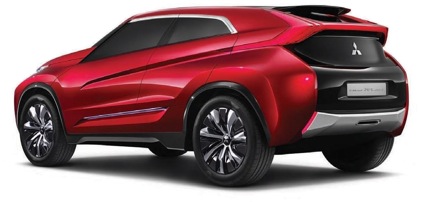Mitsubishi Concept XR-PHEV Press Kit

Mitsubishi Concept XR-PHEV
The Mitsubishi Concept XR-PHEV is a futuristic next-generation compact crossover that blends the functionality of an SUV, the dramatic, eye-catching appeal and performance of a sports coupe and the drivetrain of a plug-in hybrid electric vehicle (PHEV) into one.
The stylized and modern driver-focused cabin is highly refined, technologically-advanced and comfortable for all of the vehicle’s occupants. In addition to its futuristic design both inside and out, the Mitsubishi Concept XR-PHEV features a host of next-generation active safety system technologies and its eco-friendly PHEV drivetrain offers sports car-like performance and exceptional fuel economy because of its Mitsubishi innovative Electric Vehicle (MiEV) technology.
MiEV technology is showcased in Mitsubishi’s production cars including the highly innovative 100% electric-powered Mitsubishi i-MiEV – the most affordably-priced EV available in America today – and the Mitsubishi Outlander PHEV that is proving popular with both consumers and the media overseas. Mitsubishi’s MiEV technology is also the driving force behind the 100% electric-powered Mitsubishi MiEV Evolution III race cars that dominated the competition in the famous Pikes Peak International Hill Climb, shattering the EV class record by 38 seconds and finishing second and third overall.
Exterior Design

A track athlete huddled down in the starting blocks, poised to launch forward in a dynamic burst of energy with whirlwind acceleration is the primary inspiration behind the bold-yet-muscular exterior form of the Mitsubishi Concept XR-PHEV.
The profile of a sprinter in the starting position is symbolized through the strong yet elegantly chiseled sheet metal creases on the sides of the vehicle. These character lines, working in concert with the Concept XR-PHEV’s distinctively wedge-shaped profile, give this show car an aggressive forward-leaning stance that further epitomizes the track athlete’s form. The muscular look is also enhanced by the highly sculpted fenders that envelope oversize high-performance tires, and its low, wide stance exudes strength and performance.
Functional exterior accessories include solar cell arrays embedded within the roof to help more efficiently charge the auxiliary equipment battery, as well as an active aerodynamic device in the form of a variable angle spoiler on the trailing edge of the roof.
The exterior aesthetic of the Concept XR-PHEV embodies this crossover’s high performance and agility, as well as a hint at the design direction for future Mitsubishi production vehicles.
Interior Design

One of the most important themes behind the creation of the Concept XR-PHEV is athletic performance. Mitsubishi engineers and designers created a driver-centric interior aimed to inspire the enthusiast, ensure coordinated and precise control inputs, and instill driver confidence for optimal car control and vehicle stability at all times.
While the other seats have been upholstered in black with red accents, this color combination has been inverted for the all-important driver’s seat to make it stand out in the vehicle. Both front bucket seats are comfortable yet supportive, but the driver’s seat features additional bolstering in another nod to the importance of the driver.
The modern information display pod allows the driver to easily and instantly notice the most important driving parameters. The speedometer, tachometer and other key performance information displays/readouts are placed along the top of the dashboard, at the base of the windshield, to ensure the driver keeps his or her eyes on the road ahead.
Technology

Next-Generation PHEV with MiEV Technology
A next-generation plug-in hybrid electric vehicle (PHEV) system featuring Mitsubishi innovative Electric Vehicle (MiEV) technology provides a compelling and futuristic drivetrain to match the Mitsubishi Concept XR-PHEV’s dynamic and forward-thinking design.
MiEV technology is the proprietary EV and PHEV-based drivetrain systems of Mitsubishi Motors, featuring components and software that have been engineered to deliver outstanding capability, safety and reliability. MiEV technology powers production vehicles including the 100% electric-powered Mitsubishi i-MiEV and the plug-in hybrid Mitsubishi Outlander PHEV.
The motive force for this concept-car creation by Mitsubishi Motors comes in the form of a front engine/front-wheel drive gasoline-powered 1.1-liter inline-3-cylinder turbocharged engine (134 horsepower/100 kW) paired with a lightweight, compact and high-efficiency electric motor (161 horsepower/121 kW) with a high-boost converter and a main drive lithium-ion battery pack with storage capacity of 14 kWh (located beneath the floor of the cabin). This potent yet extremely efficient powertrain combination makes for exciting sports car-like acceleration while offering exemplary fuel and energy efficiency – truly the best of both worlds.
A new component development to the MiEV technology system which is included on the Concept XR-PHEV is the high-boost converter. This converter raises the MiEV system to 700 volts and helps to further improve energy output and efficiency from both the electric motor as well as the generator.
For additional power optimization with reduced exhaust emissions, the 1.1-liter turbocharged 3-cylinder engine benefits from the latest iteration of Mitsubishi Innovative Valve timing Electronic Control (MIVEC) variable valve-timing.
When operating from the “EV” drive setting (which is the Concept XR-PHEV’s standard driving mode), the PHEV powertrain automatically selects from the three drive system settings – EV, Series Hybrid and Parallel Hybrid. It chooses the one best-suited for that particular driving condition, taking onto consideration the remaining battery charge level within the main-drive lithium-ion battery pack. Additionally, if the driver wants to remain driving the car purely in “EV” mode, this is possible by selecting Battery Charge Mode (gas engine will operate essentially as a generator to replenish the energy supply of the main-drive lithium-ion battery pack) or in Battery Save Mode (depending on how low the energy level of the main-drive lithium-ion battery pack is, the system will reduce electric energy expenditure on “non-vital” systems such as air conditioning, etc. and will allow EV driving for a limited distance/duration).
Adding to this intelligent drivetrain’s versatility, the Concept XR-PHEV has been fitted with several 100 volt AC onboard electrical outlets that are capable of delivering an external power supply of up to 1500 watts of power. This allows the vehicle to supply enough electricity to power the typical household’s domestic appliances for a full day from energy stored within the main-drive lithium-ion battery pack and up to a maximum of 10 days when the engine (with a full tank of gas) is used to recharge the energy supply within the main-drive lithium-ion battery pack.
Connected Car Technology

The Concept XR-PHEV has been equipped with a Mitsubishi Motors advanced “connected car” technology that makes use of the next-generation information systems. The connected car systems not only provide an additional level of information and driving-related logistics in a convenient and easy-to-use system, but they can potentially reduce the risk of accidents involving other drivers as well as pedestrians/cyclists by keeping the driver better informed about traffic signal status and vehicles and objects surrounding their vehicle.
While still in the very early stages of research and development, connected car technology as developed by Mitsubishi will have a significant impact on the way we utilize our vehicles, as well as how we interact with our cars through the Internet of Things.
By linking to a vehicle information network, the Concept XR-PHEV’s connected car system uploads real-time vehicle status information to the network while simultaneously downloading external data. Information received includes traffic within the vicinity, the status of the traffic signal ahead (currently red, yellow or green), and other information to help the driver operate their car more economically and efficiently than ever before.
Another important role for connected car technology is in the area of vehicle diagnostics. For example, the system can detect if there is a mechanical issue with the car, alert the driver to the severity of the problem, then provide information so that the driver can drive to the closest Mitsubishi Motors service center in the area (if deemed necessary). Furthermore, should the vehicle be involved in an accident, the connected car system can immediately contact emergency responders as well as provide them with important information (severity of the crash, alert first responders that the vehicle has a high-voltage system if the vehicle is an EV/PHEV, etc.).
Looking further down the road, future technologies to be incorporated into the connected car system could be novel interfaces such as the AR Windshield, which makes use of augmented reality technology that would allow the driver to collect and process data more safely and efficiently without having to take their eyes off of the road ahead (see “The Future: Advanced Safety Technologies” section for more information).
Connected car technology has the potential to greatly improve driving convenience, efficiency, comfort and safety. Safety is of immense importance to Mitsubishi Motors as the company continues in its never-ending endeavor to earn the highest safety scores for its production vehicles, like the Insurance Institute for Highway Safety (IIHS) “Top Safety Pick+” for the 7-passenger Outlander and “Top Safety Pick” for the 5-passenger Outlander Sport.
Safety
The Mitsubishi Concept XR-PEV has been equipped with the following advanced safety systems:
Pedestrian Collision Mitigating Auto-braking
Pedestrian Collision Mitigation Auto-braking utilizes both radar- and camera-based systems to detect when a pedestrian walks in front of the vehicle, then automatically applies the brakes to help mitigate injury to the pedestrian or to avoid a collision altogether.

Rearward Blind Spot Vehicle Warning
Rearward Blind Spot Vehicle Warning helps to minimize collisions by alerting the driver of a vehicle approaching from behind. Additionally, the system will detect and alert the driver to the presence of a vehicle or other objects (pedestrians or cyclists in motion; stationary obstructions such as a parked vehicle, fire hydrant, etc.) when the driver’s own vehicle is backing up.
Unintentional Vehicle Move Off Control
The remarkably intuitive Unintentional Vehicle Move Off Control system operates through a camera mounted at the front of the vehicle working in coordination with a variety of sensors. It detects the mistaken or unintended use of the accelerator instead of the brake pedal and then limits engine power to help restrain forward movement of the vehicle. The system also issues a warning to the driver.
Driver Monitor
The Driver Monitor, using sensors in the steering system and driver’s seat, as well as a camera positioned in front of the driver, detects changes in the driver’s posture and/or eye blinking to determine their level of alertness. If the system detects any abnormalities in driving behavior caused by fatigue or inattentiveness, it will instantly alert the driver. Furthermore, if the system determines that the driver’s level of concentration has diminished or that they are taking their eyes off of the road for too long, it will sound an alert to get the driver’s attention.

Driving Safety Support System
The Driving Safety Support System helps to improve safety for both the vehicle’s occupants, as well as pedestrians/cyclists by creating communication between the vehicle and road infrastructure (in its home market, it links to the Japanese Help Net and Japanese National Police Agency).
Forward Collision Mitigation*
A radar-based system that in certain circumstances helps determine if a frontal collision is imminent, it warns the driver with audible and visual signals, and if necessary automatically applies emergency braking to reduce the severity of the collision.
Lane Departure Warning*
As its name suggests, the Lane Departure Warning system is a camera-based system that helps to monitor the lane position of the vehicle and warns the driver via visual and audio warnings should they begin to veer into the next lane.
Adaptive Cruise Control*
This radar-based sensor at the front of the vehicle constantly measures distance between itself and the vehicle in front of it, allowing the driver to select between different following distance settings.
Auto Hi-beam Headlights
Through the use of an on-board camera, the Auto Hi-beam Headlights will automatically dim when the system detects oncoming vehicles or pedestrians, re-illuminating the headlights at full strength once the objects have passed.
*The advanced next-generation safety technologies Forward Collision Mitigation, Lane Departure Warning and Adaptive Cruise Control are already available on the recently redesigned 7-passenger 2015 Mitsubishi Outlander crossover vehicle.
The Future: Advanced Safety Technologies

The advanced systems on display in the dynamic new Mitsubishi Concept XR-PHEV crossover are but a foreshadowing of the exciting and futuristic automotive-related technologies that Mitsubishi Motors Corporation (MMC) designers and engineers have in store for their customers in the not-too-distant future.
Already an industry leader in the area of 100% electric-powered vehicles (EVs) as well as plug-in hybrid electric vehicles (PHEVs), the Japanese auto manufacturer is at the forefront in the research and development of vehicle-to-infrastructure communication systems, Intelligent Transport Systems (ITS) and vehicle-to-vehicle driving assistance systems and technologies. Some of these advanced automotive technologies that will likely make their way into future Mitsubishi production cars include:
Next-Generation Driver Safety Support System
An infrastructure-to-vehicle communication system, the Driver Safety Support System improves vehicle occupant and pedestrian safety by utilizing communication between Mitsubishi vehicles and road infrastructure. This helps to prevent accidents by warning the driver of the vehicle – or pedestrians and cyclists not even visible to the driver further down the road – of each other’s presence and/or pending interaction. For example, a DSSS system using roadside sensors and cameras could send pedestrian/cyclist info through a vehicle-mounted communication system, thus helping to reduce the chance of an accident.
Mitsubishi Electric Vehicle (EV) Operation via Smartphone Remote Control
Mitsubishi Motors Corporation designers and engineers are working on new ways to improve the ease of use and convenience of 100% electric-powered vehicles that will soon make their way into the company’s production models as part of its Intelligent Transport Systems (ITS) efforts.
The introductory phase of this program will likely include user-friendly smartphone apps that will allow Mitsubishi electric vehicle owners to:
- Help determine the most cost efficient means of vehicle charging
- Check on electricity rates in varying locations
- Help select off-peak times to charge their EVs
Additionally, Mitsubishi Motors is working on developing smartphone apps for all of their customers to be able to obtain current city street and freeway information as well as traffic conditions.
AR Windshield

The AR Windshield makes use of augmented reality technology to display critical data to the driver while the vehicle is on the move, greatly improving safety for the vehicle’s occupants as well as pedestrians by allowing drivers to more efficiently maintain control of their car without taking their eyes off of the road in front of them. Information projected onto the windshield could include:
- Satellite navigation-based drive route guidance
- Distance to vehicle ahead
- Lane Departure Warning alerts
- Vehicles/pedestrians in blind spots
- Caution Tracking information that includes vehicle-to-vehicle communications
Lane Keep Assist
Lane Keep Assist technology provides handling support if deemed necessary to prevent the driver from drifting out of their lane due to inattentiveness or fatigue. Along with a traffic sign recognition system that uses an on-board camera to recognize road signs, the system can further alert the driver about the road signs through additional information and/or warnings. In the event of an emergency, the system will then activate an engine speed limiter.
Cooperative Adaptive Cruise Control
Working in tandem with the Lane Keep Assist system, Cooperative Adaptive Cruise Control provides forward visual assistance on roads and highways by sharing acceleration, deceleration and braking input information with the vehicle in front of it by using vehicle-to-vehicle as well as available vehicle-to-infrastructure communication systems to establish and maintain accurate and efficient distances between the two vehicles. This not only helps to improve safety but also encourages more efficient vehicle operation as well by reducing traffic congestion.
Mitsubishi Concept XR-PHEV Specifications (Manufacturer Targets)
|
Length x Width x Height |
4,370 mm × 1,870 mm × 1,570 mm |
|
|
Occupants |
4 |
|
|
Hybrid Fuel |
>65 mpg |
|
|
Plug-in Cruising |
>53 miles |
|
|
Engine |
Configuration |
1.1-liter 3 cylinder direct injected turbocharged MIVEC, gasoline |
|
Max Output |
134 bhp (100 kW) |
|
|
Electric Motor |
120 kW (161 bhp) |
|
|
Battery Capacity |
14 kWh |
|
|
Transmission |
Transaxle |
|
|
Drivetrain |
FWD |
|

